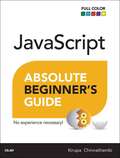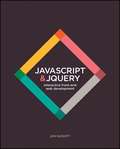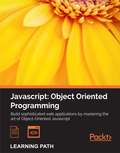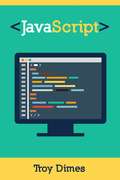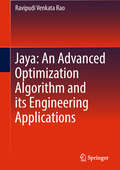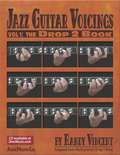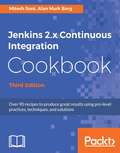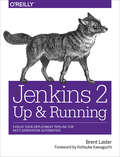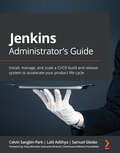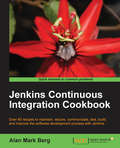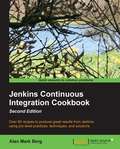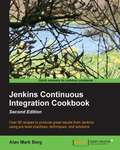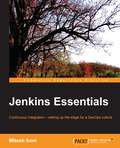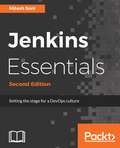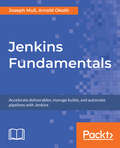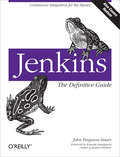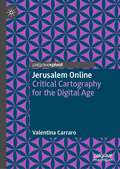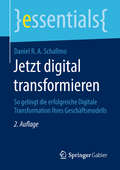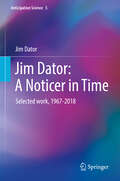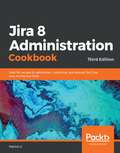- Table View
- List View
Javascript Absolute Beginner's Guide (Absolute Beginner's Guide Series-;)
by Kirupa ChinnathambiJavaScript Absolute Beginner's Guide No experience necessary! Make the most of JavaScript -- even if you've never programmed anything before. This book is the fastest way to learn JavaScript and use it together with CSS3 and HTML5 to create powerful web and mobile experiences. Learn how to do what you want, the way you want, one incredibly easy step at a time. JavaScript has never been this simple! This is the easiest, most practical beginner’s guide to programming JavaScript with simple, reliable instructions for doing everything you really want to do!
Javascript and JQuery: Interactive Front-End Web Development
by Jon DuckettLearn JavaScript and jQuery a nicer way This full-color book adopts a visual approach to teaching JavaScript & jQuery, showing you how to make web pages more interactive and interfaces more intuitive through the use of inspiring code examples, infographics, and photography. The content assumes no previous programming experience, other than knowing how to create a basic web page in HTML & CSS. You'll learn how to achieve techniques seen on many popular websites (such as adding animation, tabbed panels, content sliders, form validation, interactive galleries, and sorting data). . Introduces core programming concepts in JavaScript and jQuery Uses clear descriptions, inspiring examples, and easy-to-follow diagrams Teaches you how to create scripts from scratch, and understand the thousands of JavaScripts, JavaScript APIs, and jQuery plugins that are available on the web Demonstrates the latest practices in progressive enhancement, cross-browser compatibility, and when you may be better off using CSS3 If you're looking to create more enriching web experiences and express your creativity through code, then this is the book for you. This book is also available as part of a set in hardcover - Web Design with HTML, CSS, JavaScript and jQuery, 9781119038634 - and in softcover - Web Design with HTML, CSS, JavaScript and jQuery, 9781118907443.
Javascript: Object Oriented Programming
by Stoyan Stefanov Ved Antani Gaston C. Hillar Kumar Chetan SharmaBuild sophisticated web applications by mastering the art of Object-Oriented Javascript About This Book * Learn popular Object-Oriented programming (OOP) principles and design patterns to build robust apps * Implement Object-Oriented concepts in a wide range of frontend architectures * Capture objects from real-world elements and create object-oriented code that represents them * Learn the latest ES6 features and how to test and debug issues with JavaScript code using various modern mechanisms Who This Book Is For JavaScript developers looking to enhance their web developments skills by learning object-oriented programming. What You Will Learn * Get acquainted with the basics of JavaScript language constructs along with object-oriented programming and its application. * Learn to build scalable server application in JavaScript using Node.js * Generate instances in three programming languages: Python, JavaScript, and C# * Work with a combination of access modifiers, prefixes, properties, fields, attributes, and local variables to encapsulate and hide data * Master DOM manipulation, cross-browser strategies, and ES6 * Identify and apply the most common design patterns such as Singleton, Factory, Observer, Model-View-Controller, and Mediator Patterns * Design applications using a modular architecture based on SOLID principles In Detail JavaScript is the behavior, the third pillar in today's paradigm that looks at web pages as something that consists of : content (HTML), presentation (CSS), and behavior (JavaScript). Using JavaScript, you can create interactive web pages along with desktop widgets, browser, and application extensions, and other pieces of software. Object-oriented programming, which is popularly known as OOP, is basically based on the concept of objects rather than actions. The first module will help you master JavaScript and build futuristic web applications. You will start by getting acquainted with the language constructs and how to organize code easily. You develop concrete understanding of variable scoping, loops, and best practices on using types and data structures, as well as the coding style and recommended code organization patterns in JavaScript. The book will also teach you how to use arrays and objects as data structures. By the end of the book, you will understand how reactive JavaScript is going to be the new paradigm. The second module is an easy-to-follow course, which includes hands-on examples of solutions to common problems with object-oriented code. It will help to identify objects from real-life scenarios, to protect and hide data with the data encapsulation features of Python, JavaScript, and C#. You will discover the advantage of duck typing in both Python and JavaScript, while you work with interfaces and generics in C#. With a fair understanding of interfaces, multiple inheritance, and composition, you will move on to refactor existing code and to organize your source for easy maintenance and extension. The third module takes you through all the in-depth and exciting futures hidden behind the facade. You should read through this course if you want to be able to take your JavaScript skills to a new level of sophistication. Style and approach This course is a comprehensive guide where each chapter consists of best practices, constructive advice, and few easy-to-follow examples that will build up your skills as you advance through the book. Get object oriented with this course, which takes you on a journey to get acquainted with few useful hands-on tools, features, and ways to enhance your productivity using OOP techniques. It will also act as a reference guide with useful examples on resolving problems with object-oriented code in Python, JavaScript, and C#.
Javascript: Un Manuale Per Imparare La Programmazione In Javascript
by Eugenia Franzoni Troy DimesImparate il JavaScript JavaScript è un linguaggio di programmazione dinamico che viene spesso usato nei browser per controllare il comportamento delle pagine web e per interagire con gli utenti; permette la comunicazione asincrona e può aggiornare parti delle pagine web o addirittura sostituirne completamente il contenuto. Vedrete JavaScript usato per visualizzare informazioni sulla data e l'ora, per fare delle animazioni su un sito web, per validare i dati inseriti in un form, per suggerire dei risultati mentre l'utente scrive in un campo di ricerca e molto altro. JavaScript viene usato sempre di più... Anche se JavaScript è il linguaggio di programmazione client side al giorno d'oggi più diffuso, può essere usato anche come linguaggio server side; ne sono alcuni esempi Node.js, Meteor, Wakanda, CouchDB e MongoDB. Il tempo che investirete imparandolo può darvi un risultato doppio, perché questo linguaggio continua ad espandersi in sempre più aree dell'informatica. Imparate i fondamentali del linguaggio di programmazione JavaScript Non importa se volete usare JavaScript in un browser web come linguaggio client, come linguaggio server o entrambi, dovrete impararne prima i fondamenti. Questo è ciò che vi darà questo libro; quando finirete di leggerlo, vi sentirete a vostro agio nel programmare in JavaScript. Ecco alcune cose che imparerete leggendo questo libro: Quando si può usare JavaScript Come impostare il computer in modo che sia facile e comodo programmare in JavaScript Quali strumenti vi servono per programmare in JavaScript Le basi di HTML... Cosa sono le variabili e come usarle Come gestire i numeri e fare le operazioni matematiche Come e quando usare i condizionali Cosa sono le funzioni, perché sono così comode e come farne buon uso Strutture di dati avanzate come gli array associativi Molto altro... Tornate s
Jaya: An Advanced Engineering Optimization Algorithm And Its Applications
by Ravipudi Venkata RaoThis book introduces readers to the “Jaya” algorithm, an advanced optimization technique that can be applied to many physical and engineering systems. It describes the algorithm, discusses its differences with other advanced optimization techniques, and examines the applications of versions of the algorithm in mechanical, thermal, manufacturing, electrical, computer, civil and structural engineering.In real complex optimization problems, the number of parameters to be optimized can be very large and their influence on the goal function can be very complicated and nonlinear in character. Such problems cannot be solved using classical methods and advanced optimization methods need to be applied. The Jaya algorithm is an algorithm-specific parameter-less algorithm that builds on other advanced optimization techniques. The application of Jaya in several engineering disciplines is critically assessed and its success compared with other complex optimization techniques such as Genetic Algorithms (GA), Particle Swarm Optimization (PSO), Differential Evolution (DE), Artificial Bee Colony (ABC), and other recently developed algorithms.
Jazz Guitar Voicings - Vol. 1
by Sher Music Randy VincentHave you ever wondered how guitarists like Joe Pass, Jim Hall and Wes Montgomery find such full, luscious voicings for their chord melody playing? Well, much of that sound is based on the "Drop 2" principle of chord voicings. In this book, veteran guitarist Randy Vincent explains exactly how you can get that same sound too. Endorsed by Julian Lage, John Stowell, Larry Koonse, etc.
Jazz Piano Masterclass: The Drop 2 Book
by Mark Levine Sher MusicThe most comprehensive book ever written on how to create the 4-note, block-chord approach to jazz piano playing used by masters like McCoy Tyner, Bill Evans, Barry Harris, Cedar Walton, etc. In this book, world-renowned pianist and educator Mark Levine provides a step-by-step, beginning to advanced, masterclass on how to create, practice and extend this most useful appraoch to jazz chord voicings.<P><P> Advisory: Bookshare has learned that this book offers only partial accessibility. We have kept it in the collection because it is useful for some of our members. To explore further access options with us, please contact us through the Book Quality link on the right sidebar. Benetech is actively working on projects to improve accessibility issues such as these.
Jeff Bezos
by Chris McNabO HOMEM QUE REVOLUCIONOU O MUNDO DOS NEGÓCIOS Fundador e CEO da Amazon até 2021, Jeff Bezos é amplamente considerado um dos empresários mais bem-sucedidos do mundo, aparecendo nos lugares cimeiros do índice de riqueza da Forbes.Este livro debruça-se sobre as suas primeiras influências, a sua educação, as decisões que tomou na sua impressionante carreira e o modo como construiu e gere o seu império de negócios, que teve início numa startup fundada na sua própria garagem. Atualmente, Jeff Bezos mantém-se como o principal acionista da Amazon, mas os seus interesses viram-se agora para áreas como a filantropia, a educação da geração mais jovem e a exploração do espaço, tendo fundado a empresa de astronáutica Blue Origin e realizado em 2021 a sua primeira expedição ao espaço.
Jeff Smith's Senior Portrait Photography Handbook
by Jeff SmithWith detailed, informative instructions for capturing personable and memorable yearbook photos, this reference presents step-by-step demonstrations on advertising, talking to clients, producing outstanding images, and finalizing a sale. Noting the delicate balance of pleasing parents and teens alike, this resource illustrates how to marry the latest fashion-oriented photography trends with the needs of the family member who is paying for the session. A wealth of lighting and posing techniques combine with tips for analyzing the subject, choosing which features to accent and which to downplay, and creating alluring, fashionable looks that the whole family can appreciate. Emphasizing the value in allowing seniors to personalize their photos by bringing the shoot to their home or a more meaningful location, the guide also includes suggestions for incorporating additional visual elements such as pets, musical instruments, team uniforms, best friends, or significant others.
Jenkins 2.x Continuous Integration Cookbook - Third Edition
by Alan Mark Berg Mitesh SoniGet a problem-solution approach enriched with code examples for practical and easy comprehension About This Book • Explore the use of more than 40 best-of-breed plug-ins for improving efficiency • Secure and maintain Jenkins 2.x by integrating it with LDAP and CAS, which is a Single Sign-on solution • Efficiently build advanced pipelines with pipeline as code, thus increasing your team's productivity Who This Book Is For If you are a Java developer, a software architect, a technical project manager, a build manager, or a development or QA engineer, then this book is ideal for you. A basic understanding of the software development life cycle and Java development is needed, as well as a rudimentary understanding of Jenkins. What You Will Learn • Install and Configure Jenkins 2.x on AWS and Azure • Explore effective ways to manage and monitor Jenkins 2.x • Secure Jenkins 2.x using Matrix-based Security • Deploying a WAR file from Jenkins 2.x to Azure App Services and AWS Beanstalk • Automate deployment of application on AWS and Azure PaaS • Continuous Testing – Unit Test Execution, Functional Testing and Load Testing In Detail Jenkins 2.x is one of the most popular Continuous Integration servers in the market today. It was designed to maintain, secure, communicate, test, build, and improve the software development process. This book will begin by guiding you through steps for installing and configuring Jenkins 2.x on AWS and Azure. This is followed by steps that enable you to manage and monitor Jenkins 2.x. You will also explore the ways to enhance the overall security of Jenkins 2.x. You will then explore the steps involved in improving the code quality using SonarQube. Then, you will learn the ways to improve quality, followed by how to run performance and functional tests against a web application and web services. Finally, you will see what the available plugins are, concluding with best practices to improve quality. Style and approach This book provides a problem-solution approach to some common tasks and some uncommon tasks using Jenkins 2.x and is well-illustrated with practical code examples.
Jenkins 2: Evolve Your Deployment Pipeline for Next Generation Automation
by Brent LasterDesign, implement, and execute continuous delivery pipelines with a level of flexibility, control, and ease of maintenance that was not possible with Jenkins before. With this practical book, build administrators, developers, testers, and other professionals will learn how the features in Jenkins 2 let you define pipelines as code, leverage integration with other key technologies, and create automated, reliable pipelines to simplify and accelerate your DevOps environments.Author Brent Laster shows you how Jenkins 2 is significantly different from the more traditional, web-only versions of this popular open source automation platform. If you’re familiar with Jenkins and want to take advantage of the new technologies to transform your legacy pipelines or build new modern, automated continuous delivery environments, this is your book.Create continuous delivery pipelines as code with the Jenkins domain-specific languageGet practical guidance on how to migrate existing jobs and pipelinesHarness best practices and new methods for controlling access and securityExplore the structure, implementation, and use of shared pipeline librariesLearn the differences between declarative syntax and scripted syntaxLeverage new and existing project types in JenkinsUnderstand and use the new Blue Ocean graphical interfaceTake advantage of the capabilities of the underlying OS in your pipelineIntegrate analysis tools, artifact management, and containers
Jenkins Administrator's Guide: Install, manage, and scale a CI/CD build and release system to accelerate your product life cycle
by Calvin Sangbin Park Lalit Adithya Samuel Gleske Tracy MirandaBuild and manage a production Jenkins instance, complete with CI/CD pipelines using GitHub and Docker Hub, Jenkins Configuration as Code, Shared Libraries, Script Security, and optimization guidesKey FeaturesSet up production-grade Jenkins and CI/CD pipelines with GitHub and Docker Hub integrationsManage, protect, and upgrade a production Jenkins instance regardless of its size and the number of usersScale a Jenkins instance using advanced optimization tips, tricks, and best practicesBook DescriptionJenkins is a renowned name among build and release CI/CD DevOps engineers because of its usefulness in automating builds, releases, and even operations. Despite its capabilities and popularity, it's not easy to scale Jenkins in a production environment. Jenkins Administrator's Guide will not only teach you how to set up a production-grade Jenkins instance from scratch, but also cover management and scaling strategies.This book will guide you through the steps for setting up a Jenkins instance on AWS and inside a corporate firewall, while discussing design choices and configuration options, such as TLS termination points and security policies. You'll create CI/CD pipelines that are triggered through GitHub pull request events, and also understand the various Jenkinsfile syntax types to help you develop a build and release process unique to your requirements. For readers who are new to Amazon Web Services, the book has a dedicated chapter on AWS with screenshots. You'll also get to grips with Jenkins Configuration as Code, disaster recovery, upgrading plans, removing bottlenecks, and more to help you manage and scale your Jenkins instance.By the end of this book, you'll not only have a production-grade Jenkins instance with CI/CD pipelines in place, but also knowledge of best practices by industry experts.What you will learnSet up a production-grade Jenkins instance on AWS and on-premisesCreate continuous integration and continuous delivery (CI/CD) pipelines triggered by GitHub pull request eventsUse Jenkins Configuration as Code to codify a Jenkins setupBackup and restore configurations and plan for disaster recoveryPlan, communicate, execute, and roll back upgrade scenariosIdentify and remove common bottlenecks in scaling JenkinsUse Shared Libraries to develop helper functions and create new DSLsWho this book is forThis book is for both new Jenkins administrators and advanced users who want to optimize and scale Jenkins. Jenkins beginners can follow the step-by-step directions, while advanced readers can join in-depth discussions on Script Security, removing bottlenecks, and other interesting topics. Build and release CI/CD DevOps engineers of all levels will also find new and useful information to help them run a production-grade Jenkins instance following industry best practices.
Jenkins Continuous Integration Cookbook
by Alan Mark BergThis book provides a problem-solution approach to some common tasks and some uncommon tasks using Jenkins and is well-illustrated with practical code examples. If you are a Java developer, software architect, technical project manager, build manager, or development or QA engineer, this book is for you. You should have a basic understanding of the Software Development Life Cycle and Java development, as well as a rudimentary understanding of Jenkins.
Jenkins Continuous Integration Cookbook - Second Edition
by Alan Mark BergIf you are a Java developer, a software architect, a technical project manager, a build manager, or a development or QA engineer, then this book is ideal for you. A basic understanding of the software development life cycle and Java development is needed, as well as a rudimentary understanding of Jenkins.
Jenkins Continuous Integration Cookbook Second Edition
by Alan Mark Berg<P><P>Over 90 recipes to produce great results from Jenkins using pro-level practices, techniques, and solutions <P><P>About This Book <P><P>Explore the use of more than 40 best-of-breed plug-ins for improving efficiency <P><P>Secure and maintain Jenkins by integrating it with LDAP and CAS, which is a Single Sign-on solution <P><P>Step-by-step, easy-to-use instructions to optimize the existing features of Jenkins using the complete set of plug-ins that Jenkins offers <P><P>Who This Book Is For <P><P>If you are a Java developer, a software architect, a technical project manager, a build manager, or a development or QA engineer, then this book is ideal for you. <P><P>A basic understanding of the software development life cycle and Java development is needed, as well as a rudimentary understanding of Jenkins. <P><P>What You Will Learn <P><P>Integrate Jenkins with LDAP and SSO solutions <P><P>Maintain and secure Jenkins <P><P>Run an integration server firing automatic functional and performance tests <P><P>Communicate through social media and by plotting custom data <P><P>Skin Jenkins to your corporate look and feel <P><P>Refine the use of code metrics to improve quality <P><P>Write your first custom Jenkins plugin <P><P>Apply tweaks to optimize your use of Jenkins <P><P>In Detail <P><P>Jenkins is an award-wining and one of the most popular Continuous Integration servers in the market today. It was designed to maintain, secure, communicate, test, build, and improve the software development process. <P><P>This book starts by examining the most common maintenance tasks. This is followed by steps that enable you to enhance the overall security of Jenkins. You will then explore the relationship between Jenkins builds and Maven pom.xml. Then, you will learn how to use plugins to display code metrics and fail builds to improve quality, followed by how to run performance and functional tests against a web application and web services. Finally, you will see what the available plugins are, concluding with best practices to improve quality.
Jenkins Essentials
by Mitesh SoniIf you are a Jenkins novice or beginner with a basic understanding of continuous integration, then this is the book for you. Beginners in Jenkins will get quick hands-on experience and gain the confidence to go ahead and explore the use of Jenkins further.
Jenkins Essentials - Second Edition
by Mitesh SoniDevelop a base for DevOps culture by implementing Continuous Integration and Continuous Delivery including automated builds, unit test execution, packaging, and static code analysis with Jenkins 2 About This Book • Explore Continuous Integration and automation, along with how to manage and configure Jenkins • Master using Jenkins to build, test, and package Java applications • Learn about Jenkins' extensible features with automated deployment on cloud platforms such as AWS Elastic Beanstalk and Microsoft Azure App Services • Learn about creating a pipeline using Build Pipeline plugin and the Pipeline as Code feature available after the release of Jenkins 2.0 Who This Book Is For If you are a Jenkins novice or beginner with a basic or no understanding of Continuous Integration, then this is the book for you. Beginners in Jenkins will get quick hands-on experience and gain the confidence to explore the use of Jenkins further. What You Will Learn • Get to grips with the challenges faced by developer communities • Learn about Continuous Integration and how it helps build various Java applications • Facilitate the installation and configuration of Jenkins • Install and configure code repositories and build tools • Learn about the integration of Eclipse with Jenkins • Manage the integration of Jenkins, code repositories, and build tools • Familiarize yourself with Continuous Integration for Java applications with unit test execution and static code analysis • Learn about Continuous Delivery and how to deploy applications in AWS and Microsoft Azure In Detail In agile development practices, developers need to integrate their work frequently to fix bugs or to create a new feature or functionality. Jenkins is used specifically for Continuous Integration, helping to enforce the principles of agile development. This book focuses on the latest and stable release of Jenkins (2.5 and later), featuring the latest features, such as Pipeline as Code, the new setup experience, and the improved UI. With the all-new Pipeline as Code feature, you will be able to build simple or advanced pipelines easily and rapidly, hence improving your teams' productivity. This book begins by tackling the installation of the necessary software dependencies and libraries you'll need to perform Continuous Integration for a Java application. From there, you'll integrate code repositories, applications, and build tools for the implementation of Continuous Integration. Finally, you will also learn how to automate your deployment on cloud platforms such as AWS and Microsoft Azure, along with a few advanced testing techniques. Style and approach This book provides simple, step-by-step instructions, taking you from start to finish in accomplishing real-world Continuous Integration and Continuous Delivery tasks.
Jenkins Fundamentals: Accelerate deliverables, manage builds, and automate pipelines with Jenkins
by Joseph Muli Arnold OkothContinuous integration with Jenkins speeds up your projects and saves you time and moneyKey FeaturesGet a perfect balance of theories and hands-on activitiesApply continuous integration and delivery to your workflowExplore concepts such as the plugin ecosystem and adaptive build parameters, among othersBook DescriptionJenkins Fundamentals teaches you everything you need to know about installing, setting up, configuring, and integrating a Jenkins server with your project to speed up the product development life cycle. You will learn how to deploy via Docker and integrate with Git. Next you will move on to understanding bespoke plugins and services to further customize your workflow, and dynamically adjust your build requirements when pushing to production.Once you have grasped the basics, you will explore user and plugin management along with updating and upgrading Jenkins. You will set up freestyle projects and views to manage your projects, followed by configuring parameters for your projects and creating upstream and downstream projects with views to visualize the projects. In addition to this, you will create a secure connection from your master to your build slaves and configure your build tasks to run on the slave.By the end of this book, you will be able to successfully set up a Jenkins server that checks your source code repositories for changes, triggering new builds and unit tests while informing all of the key stakeholders in your organization.What you will learnSet up and deploy a Jenkins server across different platforms via DockerDesign development workflows that enable continuous integration and then easily integrate with JenkinsExplore community plugins and use them to extend core Jenkins functionalitySet up a freestyle project as well as a view to manage your projectsUnderstand source control and pipelines, and build parameters in the context of Git and JenkinsConfigure general-purpose freestyle projects, or use more formal pipeline-driven implementationExplore concepts such as the plugin ecosystem and adaptive build parameters, among othersApply continuous integration and delivery to your workflowWho this book is forJenkins Fundamentals is for you if you are a software developer, with prior experience in application development, looking to build and transition to a more centrally managed deployment process. This book is ideal if you need a real-world introduction to continuous delivery, with a view to setting up and using Jenkins as a tool for your own software development life cycle.
Jenkins: Continuous Integration for the Masses (Oreilly And Associate Ser.)
by John Ferguson SmartStreamline software development with Jenkins, the popular Java-based open source tool that has revolutionized the way teams think about Continuous Integration (CI). This complete guide shows you how to automate your build, integration, release, and deployment processes with Jenkins—and demonstrates how CI can save you time, money, and many headaches.Ideal for developers, software architects, and project managers, Jenkins: The Definitive Guide is both a CI tutorial and a comprehensive Jenkins reference. Through its wealth of best practices and real-world tips, you'll discover how easy it is to set up a CI service with Jenkins.Learn how to install, configure, and secure your Jenkins serverOrganize and monitor general-purpose build jobsIntegrate automated tests to verify builds, and set up code quality reportingEstablish effective team notification strategies and techniquesConfigure build pipelines, parameterized jobs, matrix builds, and other advanced jobsManage a farm of Jenkins servers to run distributed buildsImplement automated deployment and continuous delivery
Jerusalem Online: Critical Cartography for the Digital Age (The Contemporary City)
by Valentina CarraroThe book addresses the rapid shifts which have taken place within cartography, and argues that no amount of technological sophistication will lead to neutral representations, and that as such critical cartography provides a solid foundation for questioning the power of maps. It considers the fragmentation, dynamism and opacity that characterise online maps, and argues for the need of new ways of thinking and researching maps. The book offers an approach grounded in ‘ontological’ social theory and feminist technoscience, and illustrates it through the analysis of three Jerusalem-related mapping controversies. Using online media, historical maps and ethnographic work, each case study explores a different map provider and a recent mapping development: Google Maps and the distributed authorship of web-maps; Waze and algorithmic navigation; OpenStreetMap and crowdsourcing. The book is a key read to faculty and advanced students in Urban Studies and Critical Cartography. It will particularly appeal to those working in the digital geographies
Jess in Action: Rule-Based Systems in Java
by Ernest Friedman-HillJess in Action first introduces rule programming concepts and teaches you the Jess language. Armed with this knowledge, you then progress through a series of fully-developed applications chosen to expose you to practical rule-based development. The book shows you how you can add power and intelligence to your Java software.
Jetzt digital transformieren: So Gelingt Die Erfolgreiche Digitale Transformation Ihres Geschäftsmodells (Essentials)
by Daniel R. A. SchallmoDaniel R. A. Schallmo erläutert in der 2. Auflage dieses essentials die Digitale Transformation von Geschäftsmodellen, dargestellt an drei Beispielen. Die 1. Auflage wurde überarbeitet und um einen wesentlichen Punkt ergänzt: die Einordnung der Digitalen Transformation von Geschäftsmodellen in den Gesamtkontext der Digitalisierung. Ferner zeigt der Autor bestehende Ansätze zur Digitalen Transformation auf und entwickelt auf dieser Basis eine Roadmap, die ein Vorgehen in fünf Phasen beinhaltet. Neue Möglichkeiten der Vernetzung und Kooperation unterschiedlicher Akteure können eröffnet werden, die z. B. Daten austauschen und somit Prozesse anstoßen. In diesem Zusammenhang spielt insbesondere die Digitale Transformation von Geschäftsmodellen eine wichtige Rolle, da Geschäftsmodelle unterschiedliche Elemente enthalten, die digital transformiert werden können.
Jihadists and Weapons of Mass Destruction
by Gary Ackerman Jeremy TamsettExplores the Nexus Formed When Malevolent Actors Access Malignant MeansWritten for professionals, academics, and policymakers working at the forefront of counterterrorism efforts, Jihadists and Weapons of Mass Destruction is an authoritative and comprehensive work addressing the threat of weapons of mass destruction (WMD) in the hands of jihadists,
Jim Dator: Selected work, 1967-2018 (Anticipation Science #5)
by Jim DatorThis book features a selection of the published writings and public presentations of Jim Dator. Most of the chapters are directly concerned with futures studies and ideas about the futures. The topic covers many disciplines and subjects. It is also concerned with many different parts of the world, even Mars. In addition, a few of the earlier papers contained here are about more conventional topics in politics and religion.The collection spans a more than 50 year period of thought, reflection, and instruction. In particular, the papers examine six main topics. These include meditations on the very nature of future studies, visions of preferred futures, ideas about alternative futures, and details on future theories and methods. Coverage also considers such specific topics as AI and robots, the environment, food, culture, energy, families, future generations, and more.Overall, these papers help readers gain insight into what it takes to weave together alternative images of the future in useful ways. They also reveal cross-disciplinary patterns in key fields of human endeavor that will help readers better understand trends and emerging issues.
Jira 8 Administration Cookbook: Over 90 recipes to administer, customize, and extend Jira Core and Jira Service Desk, 3rd Edition
by Patrick LiBuild customized solutions that fulfil your business requirements using the latest features of Jira 8 Key Features Learn how to customize Jira applications to suit your organizational requirements Extend Jira's capabilities for custom integrations with other products and services such as Slack and GitHub Explore practical recipes for troubleshooting and securing your Jira instances with best practices Book Description Jira is a project management tool used widely by organizations to plan, track, and release software. Jira administrators are at the heart of these processes and need to know how to successfully administer and customize Jira offerings. This updated Jira 8 Administration Cookbook demonstrates how to efficiently work with Jira Core and Jira Service Desk. The book starts with a variety of recipes to help you manage users and workflows. You'll learn how to set up custom forms and capture important data with custom fields and screens. Next, you'll gain insights into the latest email capabilities, which assist you with everything from managing outgoing email rules to processing incoming emails for automated issue creation. Later, you'll be guided through running scripts to automate tasks, getting easy access to logs, and even working with tools to troubleshoot problems. The book will also ensure you understand how to integrate Jira with Slack, set up SSO with Google, and delegate administrator permissions. Finally, the chapter on Jira Service Desk will enable you to set up and customize your own support portal, work with internal teams to solve problems, and achieve optimized services with Service Level Agreement (SLA). By the end of this book, you'll have the skills to extend and customize your Jira implementation effectively. What you will learn Learn how to delegate administrator permissions effectively Gain insights into integrating Jira with Bitbucket Cloud and GitHub Explore ways to collaborate with your internal teams on service requests Understand how to add permissions to fields Learn how to set up SSO with Google Discover how to copy over configuration settings between Jira instances Who this book is for This book is for administrators who are looking to customize, support, and maintain Jira for their organizations. A good understanding of Jira's core concepts is a must to make the most out of this book. For certain recipes, some knowledge of HTML, CSS, JavaScript, and basic programming will also be helpful.
